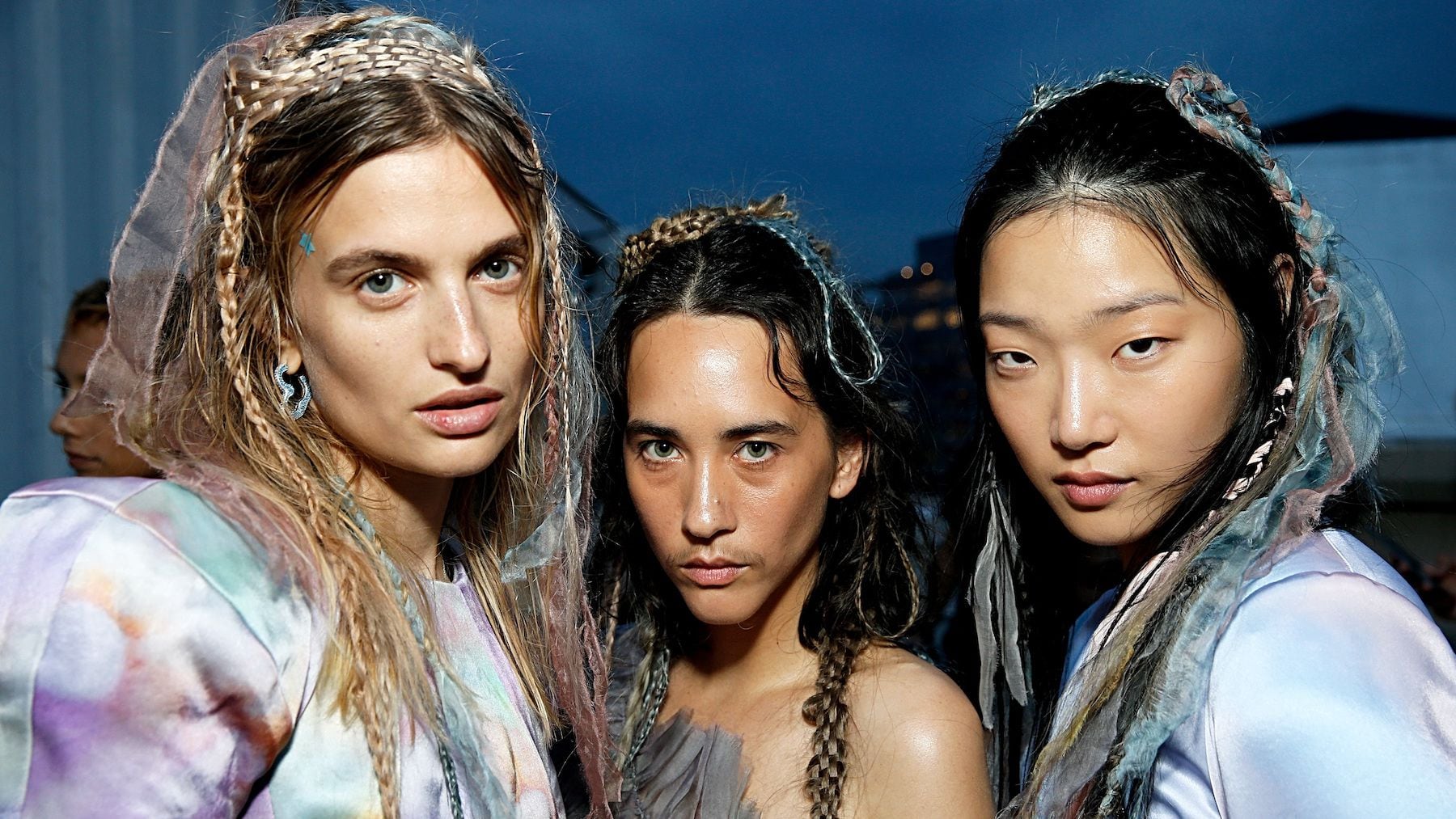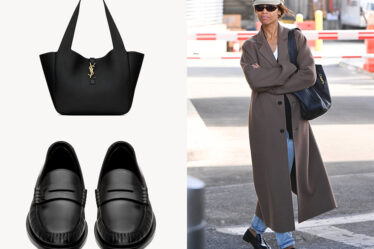
Hillary Taymour is feeling hopeful.
“There are so many small sustainable brands in New York now, and they’re appreciated,” said the Collina Strada, founder and communications guru for the Council of Fashion Designers of America’s Sustainable Strategies Committee. “It’s so different from when I started.”
Collina Strada’s rooftop sunset show Friday evening might have been one the hottest tickets at NYFW this week, but a decade ago, when Taymour first showed her signature cosmically dyed dresses made from deadstock fabric for Spring 2014, she recalls, “no one really gave a shit.”
Now, that kind of eco-friendly design mentality is all the city’s buzziest young designers want to talk about.
“It’s amazing — Gen Z is the whistleblower generation, and they’re really trying to clean up fashion,” said Taymour.
To be sure, sustainability has been getting more air time on runways for years. Copenhagen Fashion Week won’t let designers show unless they meet a minimum set of sustainability criteria. And the CFDA now encourages any brands showing in New York to take steps to conserve energy and follow the fashion version of the three Rs: reduce fashion event waste, reuse and recycle — or upcycle — materials.
But the sheer number of designers showing in New York — the commercial capital of fashion’s consumer culture — with a focus on sustainability is remarkable. There are 35 on the official calendar this season, compared with 13 on the Fall 2020 schedule, the last season of shows before seismic cultural shifts brought about by the pandemic.
“There’s more interest than ever,” said CFDA CEO Steven Kolb.
The city already played host to a roster of brands like Gabriela Hearst, Mara Hoffman and Studio 189, with a robust commitment to responsible fashion. But this season, gaps in the schedule created by the absence of once-tentpole shows from designers like Marc Jacobs, Thom Browne, and Tommy Hilfiger has also opened the door for more emerging talent.
There were seven runway debuts on the official calendar: Grace Ling, Tanner Fletcher, Mirror Palais, Advisry, Sami Miro Vintage, Kozaburo, and Fforme, the responsibly sourced modular layering resource from Louis Vuitton and The Row menswear alum Paul Helbers, by far the most experienced of this designer cohort. (Dauphinette and PH5 were also making runway debuts off-schedule).
NYFW always has its freshmen, of course, but one of the most interesting things about this class of designers is their shared commitment to environmental responsibility.
“Before, the climate crisis wasn’t so tangible, but now we see it, and we feel it,” said Julie Gilhart, chief development officer of brand incubator Tomorrow Ltd. and president of Tomorrow Consulting. “These younger designers understand that their customer likes to wear vintage and have something that’s upcycled or reworked or handmade because it’s seen as sort of cool and exclusive.”
Design and life partners Tanner Richie and Fletcher Kasell met as freshman roommates at the University of Minnesota before transferring to LIM College, where Richie studied interior design and Kasell fashion merchandising. Their brand Tanner Fletcher began as a pandemic side hustle when their post-grad employment plans fell through, and they channelled their shared love of thrifting and period interiors into products like shirts made from 1960s-era deadstock sheets that sold out on Ssense. Their runway debut on Tuesday will feature a ball gown made entirely from scraps of deadstock silk charmeuse and lace trims.
“There’s not really a point in going and making something new when there’s decades and decades and decades worth of things that can be used,” said Kasell.
This isn’t a quiet shift in design philosophy, either. Throughout the week so far, designers have made sustainability not just a show note, but a feature.
At Maria McManus’s salon-style presentation, one of at least 10 other off-calendar events by environmentally-minded labels, the designer held the audience for a few minutes after the models finished walking to “bore you all with some talk about sustainability.” She spoke of the effects of climate change on the developing world and highlighted some of the eco-responsible materials she’s using, including fishnet mesh fabricated from a blend of recycled cashmere and organic cotton and biodegradable buttons made from potato starch.
Ling, a J.Lo and Emma Chamberlain-approved Central Saint Martins and Parsons grad who has managed to make zero-waste design sexy via daring cut-out dresses made from deadstock fabric and 3D-printed hardware, showed a brown version of a stretch-jersey maxi skirt J.Lo wore on Jimmy Fallon back in 2022 to illustrate that good design should be timeless.
“I don’t think I necessarily started a brand to trailblaze or save the world — it came from my interest in 3D printing and technology, but I realised that there’s actually a lot of potential to use that as part of being environmentally aware,” Ling said.
Sami Miro Vintage’s runway debut on Saturday was titled “Zero Waste.” It delivered an exposition of the design philosophy founder Sami Miró has espoused since 2016 when she first cut up a pair of vintage jeans and placed the patch across the bust of a mesh bodysuit, winning Kylie Jenner and Bella Hadid as loyal fans. At the start, a model walked out onto the runway in a pair of high-waisted denim, which Miró transformed into a mini skirt with a long train in real-time.
Of course, designers must still grapple with the tension between participating in one of fashion’s biggest marketing moments with a show at NYFW while also leaning into a narrative around responsible consumption. But even if they don’t agree with the system, emerging designers are still often bound to it. Buyers want to see clothes in order to write orders and use the content from shows and presentations to gin up interest.
There’s also a question of whether this is just a seasonal trend or if the brands starting out with an environmentally-minded ethos now can maintain it over time as they grow their businesses and need to find a way to do their vintage and deadstock sourcing at scale.
Erin Beatty, the former design director of the socially responsible luxury brand Suno, which shuttered in 2016, and who unveiled her solo upcycling project, Rentrayage, three years later, believes both things are possible. “The key is figuring out how to design into vintage that there’s just endless amounts of such as denim, blazers, and khaki pants,” Beatty said.
According to designer Jonathan Cohen, who returned to NYFW this season after a three-year hiatus, undertaking a manufacturing audit in 2018 taught him that beyond helping the planet, finding creative uses for one’s own deadstock fabric also makes excellent business sense. “We were losing $27,000 for the production run of our best-selling dress on excess fabric that was going into a trash bag,” recalls Cohen’s business partner, Sarah Leff. Now, their factories collect remnants and scraps, and for Friday’s presentation, they used even the tiniest bits for garment linings and to make floral hair accessories woven into several of the models’ braids.
Taymour is hoping that this season’s focus simply becomes the norm.
“It should be everyone,” she says. “It should be everywhere. We should all be trying. There’s no excuse anymore.”
Editor’s Note: This article was revised on September 11, 2023 to correct the show on which J.Lo wore a Grace Ling dress in 2022.



